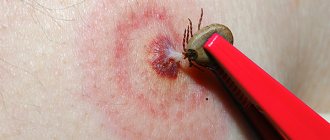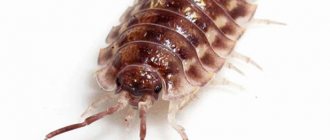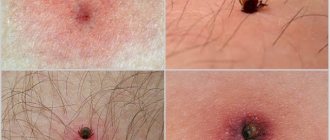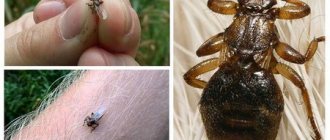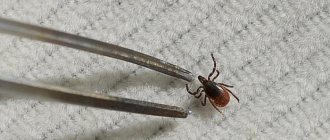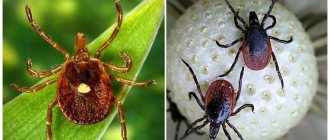Ixodid ticks are carriers of life-threatening pathogens such as encephalitis, typhus, borreliosis (Lyme disease), ehrlichiosis and many others, no less terrible. According to statistics, every sixth tick is infected with these viruses.
Such ticks are widespread throughout the globe, except Antarctica and the Arctic, parasitizing mammals, birds and humans.
Stages of development
Ixodid ticks have several stages of development - from egg to adult, which directly depend on their nutrition. During its entire life, a tick eats only four times. Stages of development:
- Larva: the shell is thin, sometimes translucent, but depends on the degree of filling with blood, size - up to one millimeter. A special distinguishing factor is the presence of three pairs of legs (an adult has four) and the absence of a genital opening. Also, in the tick larva, the anterior part of the body is covered with a dorsal shield. These are compacted segments of the chitinous cover of the tick. When the larva is sufficiently saturated with blood, and this takes it from three to six days, it enters a resting stage (like the pupa of butterflies), during which it passes into the next stage.
- Tick nymph. If the larva is a child, then the nymph is a teenager in the world of ticks. It is larger in size, up to two millimeters in length, more mobile when moving and has an almost formed reproductive system, but without an outlet. The tick nymph already has four pairs of legs. Considering that ticks live for about two years, most of them overwinter in the nymph stage.
- Imago is a sexually mature adult tick. The tick again turns from a nymph into an adult after complete satisfaction of hunger: having drunk blood, it begins the transformation in the definitive stage and, having completed it, looks for a partner to complete the most important mission - mating and laying eggs. Hungry adults are 6-8 mm in size, while well-fed adults filled with blood can increase to three centimeters.
How many years do ticks live in unfavorable conditions?
To replenish energy reserves, the ability to develop, reproduce, lay eggs, and simply live, we need the blood of animals and birds. A person becomes a temporary host, promotes further development, but significantly reduces potential. Therefore, humans are a potential victim for ixodid ticks, but not the main one.
On a note!
A tick can live for years without food. When unfavorable conditions occur, it stops moving, metabolic processes slow down, and falls into suspended animation. It can remain in this state for about 8 years. At the sight of a victim, it instantly comes to life, crawls onto the body, feeds, and continues its normal life activities.
Without blood, the pest can live longer than without water. Environmental humidity plays an important role in the development of larvae, nymphs, and the vital activity of adults.
- Parasites wake up very early, when the air temperature barely rises above 0 degrees Celsius.
- They activate activity at +10 degrees Celsius.
- A favorable temperature for them is no higher than 22 degrees Celsius. Therefore, dry summers and heat within 30 degrees Celsius kill them.
Where does this parasite usually live?
The fact that ticks and nymphs jump on people from trees is a fiction invented by people uninitiated in the particular life of the parasite. Most of its life is spent in grass or low-growing bushes, from where it ends up on human clothing, pet hair, or other “vehicles.” Not a single tick is capable of climbing a tree on its own in its entire life and from there deliberately jumping on a person in search of food. If you lay or sat on the grass on a picnic or on a hiking trip through the forests, then, of course, there is an increased likelihood that a tick or its nymph will hook its hooked legs onto the fibers of clothing and crawl onto the body in search of a tender place to bite. Tick nymphs usually parasitize only in summer, and adult ticks - from spring to autumn, being especially active from May to August. A hungry tick can wait for its victim for more than a year and a half.
Interesting facts about ticks
Below are interesting facts about ticks that will reveal a lot of surprises about these dangerous and unpleasant parasites:
- In nature, females are able to lay even unfertilized eggs, and quite viable larvae emerge from them. This process is called parthenogenesis, when the process of reproduction occurs without the participation of a sexual partner;
- Adults can go without food for a long time. Scientists have found that ticks can live without food for 2 years without harm to health;
- Over the entire period of her life, the female is capable of laying up to 15-20 thousand eggs;
- The creatures are voracious. During feeding, the female’s weight increases 80-100 times. If a person ate like this, then after lunch he would weigh 600-700 kilograms;
- After a tick bite, a person, especially an ixodid, can develop dangerous diseases. They are considered carriers of encephalitis, borreliosis (Lyme disease);
- Armored mites (oribatids) are the most powerful animals on the globe. They move loads on their bodies that are a thousand times heavier than their own weight;
- Herbivorous parasites are well camouflaged and cannot be detected in thickets of grass, trees, and bushes;
- Insect products are not suitable for pest control because they are not insects. Acaricidal (anti-mite) or insectoacaricidal (anti-mite) drugs act against them;
- Among the granary species of mites, there are many individuals that cause damage to stocks of grain, flour and other food products;
- Ticks have high survivability. They survive in a vacuum, when exposed to high temperatures, when frozen, and calmly withstand ionizing radiation.
Is a tick nymph dangerous?
For humans, this stage of the parasite is just as dangerous as an adult. The only difference is that it is difficult for a nymph to get onto a person’s body (unless, of course, he has been lying on the grass for a long time) due to the fact that at the initial stages of development the tick lives in close proximity to the soil, since that is where it spent its first days or wintering during the cold season. It physically cannot get onto a tree or large bush due to its tiny size.
Can a creature 1 mm in size overcome a distance of at least 15 meters? Hardly. The larva (the first stage after the egg) is practically safe for humans: the parasite is unlikely to be able to get onto the host’s body; he has to be content with small rodents living near the ground. Moreover, the larvae's saliva is sterile and cannot transmit viruses. Is a ixodid tick nymph dangerous if it has already sucked blood from another? No, she is preparing for the next transformation, so her tasks are completely different, and her full belly is unlikely to require supplements.
Favorable conditions for reproduction
- For unhindered reproduction, parasites need favorable conditions. Moisture is very important, so the more precipitation, the more comfortable it is for them. Of course, food, so they settle closer to potential victims so that they can regularly get enough. And lastly, temperature, they cannot tolerate cold or heat, warm weather is optimal. On hot days, they hide in the thickets, where it is cool and humid.
- These conditions influence the fact that in some years their numbers drop significantly, when there is little rainfall and the weather is mostly hot and sunny. But there are years when populations increase significantly, and weather conditions contribute to this.
- It is also worth saying that natural conditions are the usual environment for these parasites. But unfortunately, they move from their usual environment to farms and pastures, and man himself is to blame for this. Because deforestation leads to mass migrations of insects. This situation is quite dangerous, especially for people and animals. After all, along with ticks come dangerous diseases, which means that there is a risk of epidemics.
Can a nymph carry encephalitis?
A tick of any species belonging to the ixodid family (the family of parasitiforms) is a carrier and distributor of all the viruses that it carries on its body. And the nymph, as is already known, has the same degree of possibility of infection as an adult tick. Accordingly, it can also infect a person with dangerous diseases through a bite.
The virus that causes the disease is transmitted from the tick nymph to humans through the saliva of the parasite and quickly spreads throughout the body through the circulatory system. If you are bitten, you need to act quickly and purposefully.
Insect or not
The order mites are part of the arachnid family. As you know, these arthropods are not insects, they are animals, just like spiders. But they are still very similar to insects; at first glance it is difficult to distinguish them.
However, parasitic mites and insects have different external body structures:
- Insects have three pairs of legs, and mites have 4;
- Arthropods, unlike insects, do not have antennae;
- In mites, the body is divided into two segments - the abdomen and cephalothorax, and in insects into three - the head, thorax, and abdomen.
What to do?
So, what to do if a nymph is bitten by a tick? This happens very rarely, due to the fact that this stage of tick development does not allow it to rise above the grass. If you suddenly find that the nymph has already attached itself, then first of all coat its body with vegetable oil. The respiratory tract of ticks is located on the abdomen, the oil will close these openings, and the nymph will have to look for a way out in just a few minutes. Carefully pry it up with tweezers and remove.
If an adult has attached itself, then also try to manipulate the oil. Melted paraffin from a candle helps a lot: fill the insect's abdomen with hot paraffin and wait a few minutes.
Another method of getting rid of an attached imago is to lubricate it with kerosene. This will cause him to move and loosen his bite grip. Carefully grasping the tick with tweezers and making light rotational movements in different directions, we remove the parasite. In any case, be sure to go to the medical center, taking with you the body of the nymph and the tick for testing in the laboratory for the presence of dangerous viruses. It is recommended to treat the bite site with iodine for several days in a row - 3-5 times a day.
Means of protection against nymphs and ticks
Methods of personal protection against parasites of this kind are quite simple and accessible to everyone. By adhering to them, you can move freely across any terrain without fear of being bitten or infected:
- If you are going for a walk in the forest, it is better to wear light-colored clothes (this makes it easier to spot ticks) with long sleeves, and tuck your pants into socks or boots.
- Use repellents (sprays, lotions and aerosols) against ticks, applying them to clothing, following the instructions.
- If there is an individual intolerance to synthetic products, then you can use essential oils of clove, rosemary or mint. We apply them to clothes or exposed parts of the body.
- Ticks cannot stand the smell of marigolds, lavender and geraniums, so you can pick a few plants and put them in your pockets.
- Upon return, be sure to carefully examine your clothing and body for the presence of nymphs or attached ticks.
- If the work involves a long stay in forests or other places where ticks accumulate, then it makes sense to vaccinate.
Many rumors about the danger of contracting encephalitis are exaggerated due to people’s ignorance of the main thing: a tick nymph bite is not a 100% infection, but only a probability, because only one sixth of all ticks and nymphs are carriers of infection. Take precautions and don’t focus on the bad, because as they say: “If you’re afraid of wolves, don’t go into the forest.”
How to remove a tick?
Often, when a person sees a tick on himself, he instantly tears off its head: the person pulls the bloodsucker’s body, and the head remains under his skin. Neither the first nor the second are interested in such a development of events.
The easiest way is to take a cotton swab and apply oil to the skin around the bloodsucker. The oil will get into the tick's respiratory passages (and they are located not on the head, but behind the fourth pair of legs) - it will begin to choke and crawl out on its own. If there is no oil, you can use vodka, gasoline and even nail polish. The wound must be treated with iodine.
There is also a special tool for pulling out pliers - it looks like a small nail puller. Please note: no need to pull! You should carefully unscrew the tick from the skin.
You can also pull out a tick with a thread. A strong thread is tied into a knot as close as possible to the tick’s proboscis, then twisted in one direction, pulling it up a little until the tick unscrews.
Take care of those who are of the same blood with you - this is the law of the jungle.
